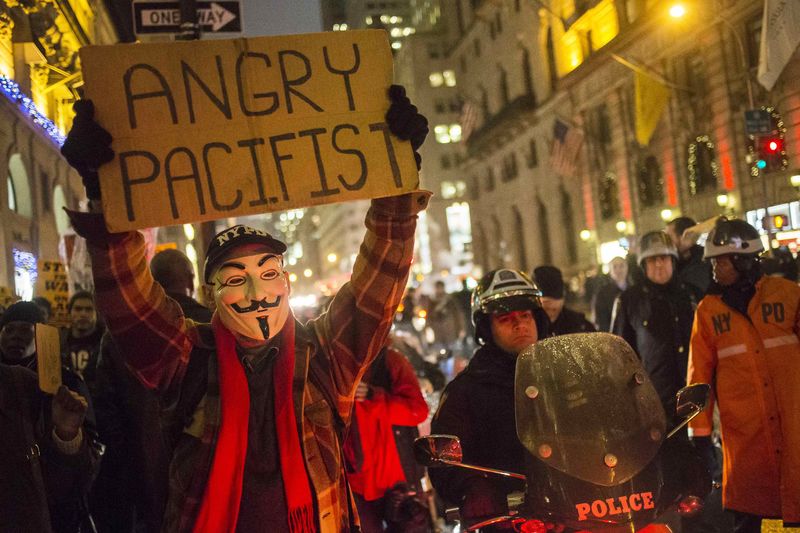By Edwin Chan and Alex Dobuzinskis
SAN FRANCISCO/LOS ANGELES (Reuters) - U.S. law enforcement agencies are a long way from being able to effectively track threats of the kind a gunman posted on Instagram before his execution-style murder of two New York City policemen last weekend.
Police need more data analytics and mining software to monitor social media sites such as Facebook (O:FB) and Twitter (N:TWTR), as well as trained personnel to make sense of what could be a deluge of data, say law enforcement officials and security experts.
"You can buy all the technology you want, but if you want to figure out clever stuff, you better have smart people able to use it," said Christopher Ahlberg, co-founder of Recorded Future Inc, which helps clients analyze social media feeds. The company is partly backed by In-Q-Tel, a venture capital firm that serves U.S. intelligence agencies.
According to the New York Police Department, Ismaaiyl Brinsley posted anti-cop slurs on the Instagram photo-sharing site hours before walking up to two officers in a parked squad car in Brooklyn and shooting them dead on Saturday.
Baltimore police said they discovered the Instagram posts after Brinsley shot and wounded his girlfriend earlier that day. But the NYPD did not learn of the posts - which included a photograph of a silver handgun and the message "I'm Putting Wings On Pigs Today. They Take 1 Of Ours...Let's Take 2 of Theirs" - until it was too late.
Monitoring social media for out-of-the-blue threats may be beyond the capabilities of most police forces including even the New York Police Department, which has a relatively extensive and aggressive intelligence operation, experts say.
Analysts at the New York and Los Angeles police departments routinely crawl through social media to keep tabs on individuals on their radar, such as gang members, or to prepare for high-profile events. But in an era of shrinking or stagnant budgets, buying high-end software and hiring trained data analysts can be costly.
Many police departments utilize fairly rudimentary tools. The NYPD uses common search engines, experts say. It is possible to program an algorithm to pick up threatening messages, but the sheer volume of data and the potential number of "false positives" would impede its effectiveness.
"It is like trying to take a sip from a fire hydrant," the non-profit Police Executive Research Forum said in a 2013 report.
TOO MUCH INFORMATION
In monitoring social media, most local police forces lag U.S. intelligence agencies, which despite their vast surveillance networks still struggle to prevent attacks such as the 2013 Boston Marathon bombing.
The National Security Agency had raw intercepts pointing to a person matching the 2009 "underwear bomber's" description, but failed to stop him from boarding a plane.
The Department of Homeland Security monitors about 100 social media sites, but there are restrictions that keep their agents from sharing all the information that they collect directly with local law enforcement.
Social media monitoring by police tends to be reactive: analysts hit the Internet when someone phones in a tip. Investigators use social networking sites to identify victims, look for witnesses and perpetrators, generate leads or search for evidence in the aftermath of a crime.
"Most of the stuff, honestly, we get is when people send it to us," said Los Angeles Police Department spokesman, Commander Andrew Smith.
That's not to say there have not been some successes. The LAPD, which employs around 40 people to monitor social media manually, uses software from a startup called PredPol Inc, which stands for predictive policing. The software analyzes LAPD and other internal police databases to identify crime-ridden areas and determine the best times to patrol.
PredPol marketing manager Benjamin Hoehn said crime dropped around 20 percent within 10 months of deploying the system in Modesto, California, in January.
The LAPD is also exploring the use of Geofeedia Inc, which incorporates user-location data as it crawls through sites from Twitter and Facebook to Google Inc's (O:GOOGL) YouTube and Yahoo Inc's (O:YHOO) Flickr.
PRIVACY CONCERNS
Sophisticated services provided by the likes of Palantir Technologies Inc, which aids intelligence agencies in counter-terrorism, can track a person's movements, identify anonymous messages from writing patterns, or establish an individual's daily routines based on social media activity, experts said.
Ahlberg said Recorded Future can predict areas where social unrest will erupt with a high degree of accuracy, based on online commentary and other data, offering a glimpse of what may be possible.
Rights organizations have criticized the increasing use of social media crawling by law enforcement as a potential violation of privacy. Others argue anything posted on social media is fair game.

"You can call it infringing on their Frist Amendment rights but these are the 21st century tools available," said ex-FBI agent Kenneth Springer, who runs investigations outfit Corporate Solutions Inc.
(Reporting by Edwin Chan; Additional reporting by Mark Hosenball and Julia Edwards; Editing by Tiffany Wu)